Disclosure: Meeple Mountain received a free copy of this product in exchange for an honest, unbiased review. This review is not intended to be an endorsement.
“It sure is hot,” you think to yourself, straightening up from the stooped posture you’ve been maintaining ever since you first began working in your garden. The rosemary and thyme are coming in nicely and you’ve snagged a few sprigs of mint for the mojito you’ve just decided that you deserve for all of your hard labor. Your back crackles with sounds that remind you you’re not as young as you used to be. Sweat dampens your brow. Despite the discomfort, you are content. You are in your element.
You take a deep breath enjoying the heady aroma of freshly turned earth commingling with the scents of herbs and blossoming flowers. Inspired, you decide that the inside of your home could benefit from a touch of nature. Tucking your mint into the pocket of your apron, you begin making your way to the flower garden, clippers in hand. Time to build a bouquet.
Overview
Taking cues from its sister games Herbaceous and Herbaceous Sprouts, Floriferous returns the players to the garden. Only this time they’re not planting and potting herbs, they’re picking flowers and combining them into (hopefully) high scoring arrangements. Much like its predecessors, Floriferous is a set collection game at heart. Herbaceous had players adding cards to both a personal and a communal tableau and making their set collection decisions based on those. But Floriferous begins with a pre-set display and has the players selecting a card from one column at a time. Each selected Flower card has three unique properties – type, color, and possibly bugs. These properties are what drive the player’s choices.

Each game has 3 public objectives that are worth victory points (VP) if players are able to fulfill them by game’s end. Additionally, the bottom card in each column will always be a Desire card (i.e. personal objective) that one of the players can choose to take in lieu of selecting a Flower card. But selecting this card will ensure that the player will be making their selection last in the next round because, you see, the turn order for each round is determined by where each player’s pawn wound up the round before. The higher in the column a player ended their previous turn, the earlier they’ll take their turn in the following one.

The game is played over a series of 3 days which are divided into 5 rounds each. At the end of the third day, players will total up their points and the player with the most wins. Of course, this is just a high level overview of the game. If you think you’ve heard enough and want to see what I think, feel free to skip ahead to the Thoughts section. Otherwise, read on.
Constructing Your Garden
To set up for the first day of Floriferous, begin by separating the various card types and shuffling them to create their own decks: Garden card, Desire card, and Bounty card decks. 3 Bounty cards are drawn and placed side-by-side at the top of the playing area with the remaining Bounty cards being returned to the box. Then 5 columns of Garden cards consisting of a number of rows determined by player count will be laid out beneath these face up (but there will be at least 2 placed face down). Some Stone tokens will be placed on top of a few of these cards. At the bottom of each column will be placed a randomly drawn, face up Desire card. The Garden card and Desire card decks should be kept close by along with the Cup of Tea card.
Next, each player selects a color and takes a player aid along with the Gardener pawns and Flower tokens of the chosen color. A starting player is selected by some means and their Gardener pawn is placed to the left of the top card of the leftmost column. The other players’ pawns are placed beneath this one in clockwise order. And with that, you’re ready to begin playing Floriferous.

It should be noted here that the set up for the beginning of each day follows the same steps as above with only a few slight differences. When a new day begins the pawns remain where they are, any unselected Garden and Desire cards are removed and then replaced with new ones. On the first day, the player pawns move left to right, then right to left on day two (new cards are laid out to the left of the player pawns), and left to right again on Day 3 (cards are laid out to the right of the player pawns). The Bounty cards are never removed.
Preparing Your Arrangement
Playing through a round of Floriferous is as easy as moving your pawn, on your turn, to any 1 of the cards in the next column and then taking the selected card into your possession. The choice of which card to take, though… therein lies the rub. One consideration is turn order as I already discussed. If there’s a card in the next column that you want to ensure you’ll be able to get, then taking the top card of the current column is the only way to ensure that’ll happen, even if the top card of the current column doesn’t really help you in any meaningful way. If you’ve played 2017’s Spiel des Jahres winner Kingdomino then you’ll recognize the agonizing decisions that result from this turn order mechanic.
As mentioned previously, each Flower card has 3 important aspects: type, color, and possibly bugs. During setup 3 Bounty cards were laid out at the top of the card display. Each of these features 3 different icons (some combination of types and bugs) with 3 spots corresponding to each of the 3 days. If a player is able to complete a collection of Flower cards that match the criteria on one of these cards, they will place 1 of their Flower tokens on it on the spot corresponding to whichever day the game is currently in. For instance: completed the objective on Day 2? Then place your Flower token onto the card in the Day 2 space. The earlier you can complete the objective on a Bounty card, the more points you’ll earn at the end of the game and each Bounty card can only be claimed by a player once.
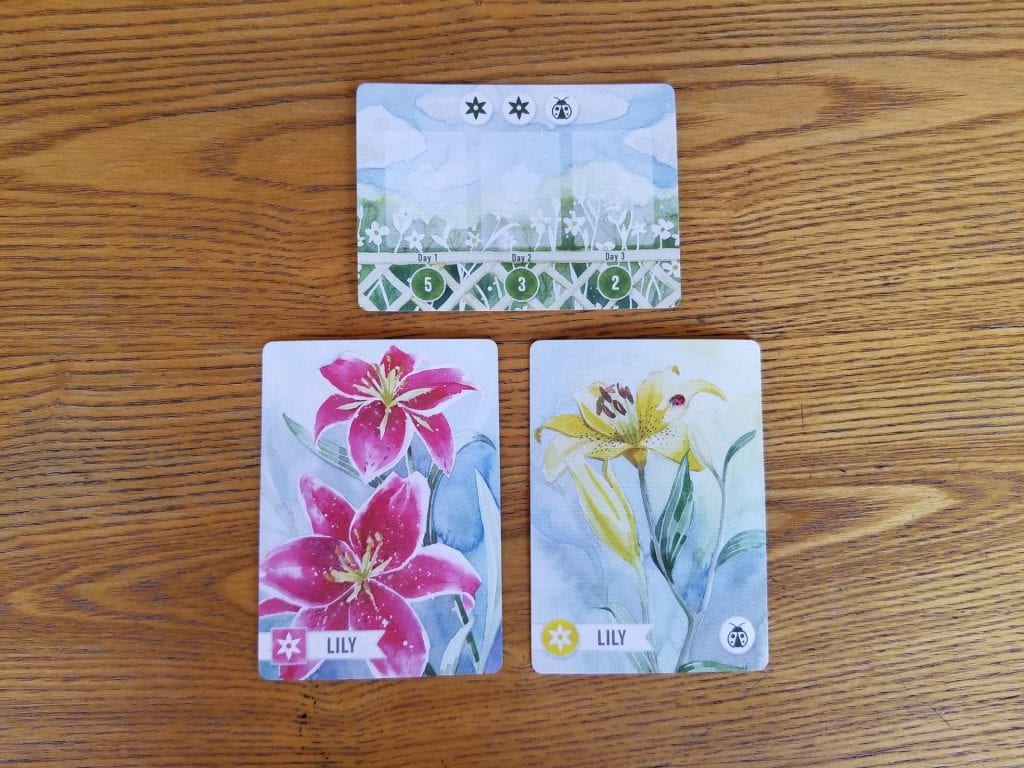
So that’s two considerations. Your other considerations will largely be driven by which Desire cards you’ve picked up. You’ve got a Desire card that awards end game points for each red flower you’ve picked up? Chances are you’ll be going after every red flower that you can get your hands on. Got another Desire card that awards points for every mum you have? Red mums are going to be your best friends because of the synergy between these 2 Desire cards. But remember, selecting a Desire card guarantees you’ll be choosing last in the upcoming round.

There are other considerations as well. The person that has collected the most stones at the end of the game will receive the Cup of Tea card which is worth an extra 2 VP. And not every Flower card features a certain type of flower on it. There are 2 additional types of Flower cards: Arrangement and Sculpture cards. Arrangement cards feature 3 icons along the bottom: a type, a color, and a bug. If the player has all 3 present in their collection at the game’s end, they’ll score 5 points with fewer points being awarded for lacking the criteria.
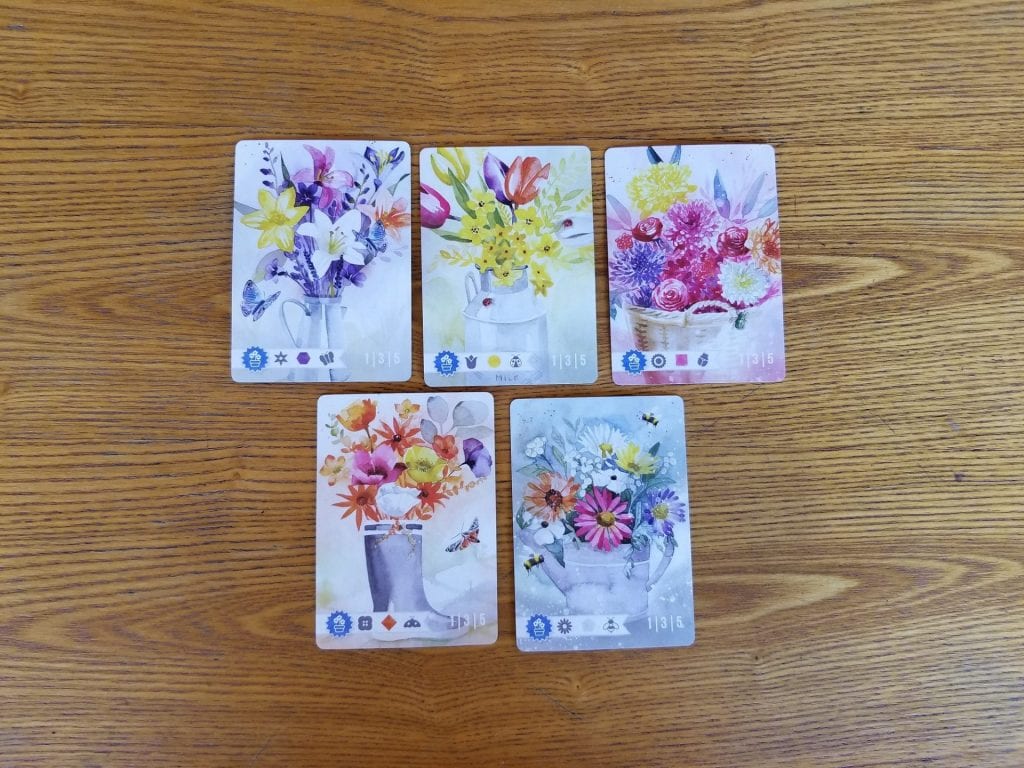
Sculpture cards award varying VP to players based on who has the most, the second most, and third most Sculptures in their collection at the end of the game.
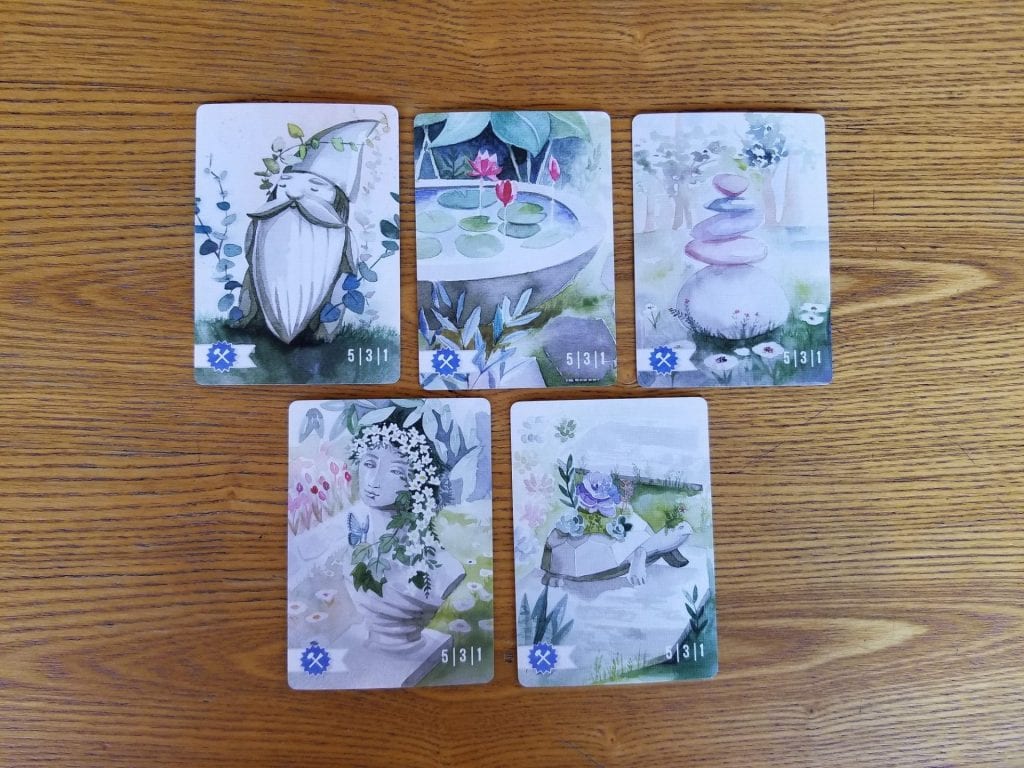
Calculating Success
Once the players have moved through all of the columns, the day comes to an end and the board is reset for a new one. At the end of 3 days, the players add up the points earned from the Sculpture, Arrangement, Cup of Tea, Bounty, and any Desire cards they have picked up. Every 2 collected stones also awards a VP. Whoever has the most VP wins.
Thoughts
What makes a game attractive to a potential buyer?
For some, it’s the publisher. If you need proof, just check out any Kickstarter campaign for any CMON project or the pre-order for any Stonemaier Games title. People have come to associate these publishers with finely crafted games and will gladly throw down their money for their products based on just that alone regardless of the game.
For some, it’s the designer’s name on the box. When I hear Uwe Rosenberg or Stefan Feld have got a new game on the horizon, I’m all over it sight unseen. These are designers who I trust. I know that with very few exceptions, they always put out a product that’s phenomenal and I know that I can expect an amazing experience.
For some, it’s the game mechanics. I’m a sucker for worker placement and deck building. There’s just something about those mechanics that sings to me. I love the feeling that deck builders give me when I’m able to crank out very satisfying turns and I love the crunchy decisions worker placement games force me to make.
For some, it’s the artwork. Ian O’ Toole. Kwanchai Moriya. The Mico. Beth Sobel. These artists have instantly recognizable styles. And they don’t just illustrate anything. When you see their name on the box, you know what to expect – great game play and phenomenal eye candy.
Well, Floriferous has got all of that. Pencil First Games is a publisher that I know I can trust. Steve Finn and Eduardo Baraf are a dynamite team producing titles like Sunset Over Water, The Whatnot Cabinet, and the aforementioned Herbaceous. From card drafting giants such as Sushi Go where set collection takes center stage to eurogame staples such as Five Tribes where the mechanic is but one of several viable paths to victory, there’s no denying the appeal of a good set collection game.
And while I’ll admit that I definitely find all of these features of Floriferous attractive, what immediately grabbed my attention wasn’t the publisher or the designer or the gameplay. What drew me in, like a moth to a flame, is the artwork. And, surprisingly for anyone that’s familiar with Pencil First Games, it isn’t Beth Sobel’s phenomenal work that you’ll find inside the box.
As the story goes, Eduardo Baraf (Edo) had an idea and that idea involved flowers. After approaching Beth Sobel, who was unavailable, about illustrating Floriferous he began searching in earnest for someone that could understand his vision and bring it into reality. After a lot of going back and forth with various candidates without finding that perfect match, he found himself having a conversation with Jamey Stegmaier (designer of Scythe and owner of Stonemaier Games). Jamey knew a person that was perfect. He put Edo in touch and the rest was history.
That person was Clémentine Campardou. Her beautiful watercolor work is invariably the first thing that anybody notices about this game. There is a reverence in the way that she paints that reminds me of the way that Elizabeth Hargrove approached birdwatching in Wingspan. Elizabeth Hargrove’s masterpiece is more than just a game about creating point scoring combos using cards with birds on them. It’s a celebration of the subject matter. That love she has for those winged creatures is infectious. It’s impossible to walk away from Wingspan without looking at birds in a different way. Similarly, Clémentine Campardou isn’t just painting flowers. She is Painting Flowers. These flowers are characters in a story. Her choice of color palette, her delicate brushstrokes, and even the inclusion of tiny little details like a ladybug precariously perched on a petal lend the illustrations a vibrancy that almost makes them feel alive.
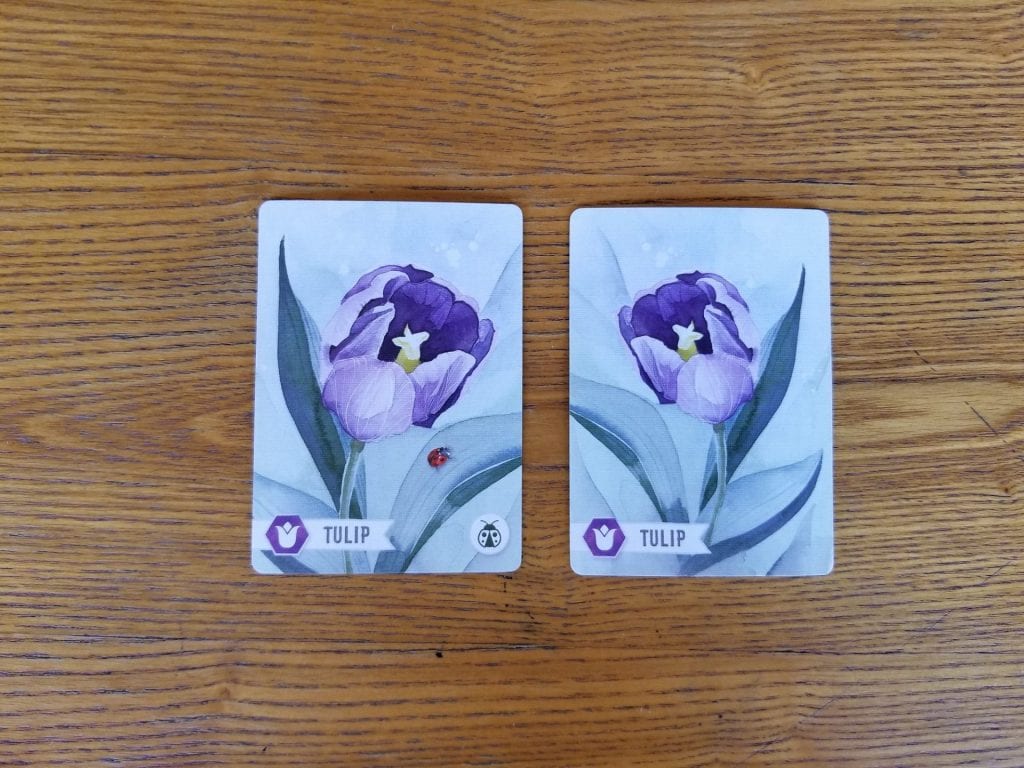
And while we’re on the subject of the way that the game looks, it’s worth pointing out that Edo et. al have gone out of their way to make this game colorblind friendly. Each color sits atop a uniquely shaped icon. If you see a circle, you know it’s yellow. If you see a diamond, you know that’s orange. There’s even unique iconography for each different Flower and bug type. In a board gaming world that tends to gravitate to the primary colors and the color green, it’s always refreshing to see publishers trying their best to be more inclusive.
Enough about the artwork and graphic design, though. Let’s talk about the gameplay.
There’s an adage in cooking competition shows that goes something like this: “If you’re going to do something classic, you’d better do it right.” The world of boardgaming, much like the world of competitive cooking, tends to reward ingenuity and uniqueness. Impress the judges with a dish they’ve never had before and that will elevate you above your competition. Design a good board game with a clever new mechanic and players will flock to it in droves. It’s much harder to impress when your creation isn’t something shiny and new. If you’re serving up steak and potatoes, the steak better be cooked to perfection and seasoned well and those potatoes had better blow peoples’ minds. If you’re serving up a dish of classic set collection, your product had better be polished and engaging. It must leave the players feeling full and satisfied and hungry for more. That’s Floriferous.
Floriferous isn’t breaking any new ground. There’s nothing in this game that hasn’t been done before. But it does it right. Even though you’re playing a game with tried and true mechanics, you still walk away from the experience feeling full and satisfied. There’s a simplicity to it that belies the game’s true depth. Every decision matters and every decision leaves you wondering if you made the right one. My only gripe (and it’s a small one) is that it can sometimes be difficult to move yourself out of that last spot in turn order, which can be frustrating if it happens for more than a couple of turns. But eventually the person that’s hanging onto first place in turn order will have to acquire a Desire card or else they’re going to lose. Being stuck in last place never lasts for long.
What makes a game attractive to a potential buyer? After playing this game you can add seeing “This game reminds me of Floriferous” on the box cover to the list. Floriferous is just amazing: compact box that you can almost fit in your pocket, small footprint, easy set up, quick teach and playtime, intuitive mechanics, challenging decisions, and did I mention the artwork? All of these combine to create a tranquil experience that will have you wanting more. More flowers. More garden gnomes. More bugs.


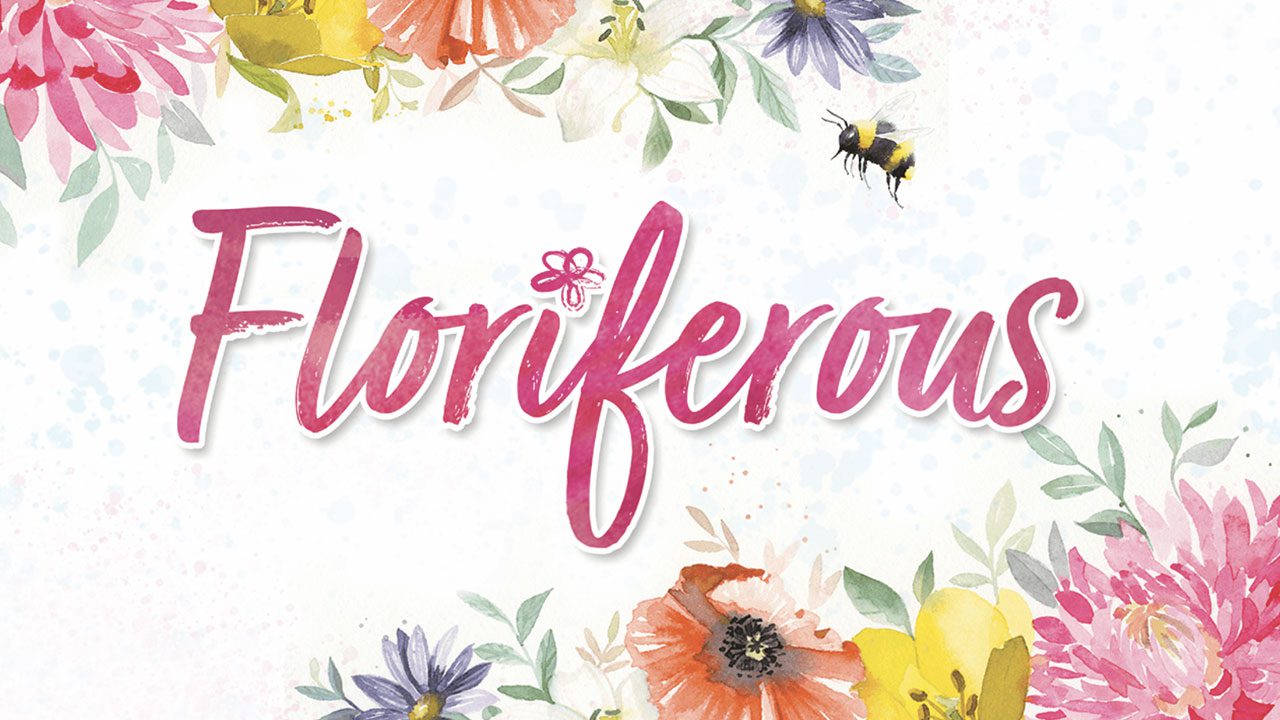









Hi! the review is good — thanks for that. I just wanted to let you know that the first few image links are broken; all I get is a blank space with the broken link icon. Have a great day!
Hello. Thanks for the comments and compliments. I’m pleased you enjoyed the review. As for the broken links, they look fine on my machine. You may want to try clearing your browser cache and/or using Shift+reload to reload the site.
That have since corrected themselves. Not sure what it was. But yes — very nice review and it looks all the more beautiful thanks to the pictures I can now see. 🙂
I will have to check this one out.